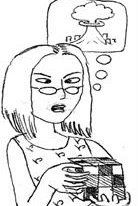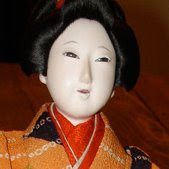Despite or maybe because of the efforts of the odious shopkeeper, I was enchanted by the
 miniature white-faced dolls with their black teeth and their long black hair, and their multi-layered court robes, and resolved to find myself one on that yardsale of the internet, Ebay.
miniature white-faced dolls with their black teeth and their long black hair, and their multi-layered court robes, and resolved to find myself one on that yardsale of the internet, Ebay.My collection has grown into a small army of geishas, musicians, court ladies, and princes since then. I like to joke that I'm going to lead my army of creepy dolls to take over Gotham City a la The Penguin.
You can find a lot of basic facts on Ningyo (Japanese Dolls) on the internet, but not many specifics. There's not a lot of literature in english on the subject. Ningyo are more along the lines of sculptures and other works of art than playthings, but they are very rarely signed, and often the head and hands will be made by one person while another will make the body and dress the doll. For some basic stuff on Ningyo and their types, you should look here.
For pictures of some museum quality Ningyo that I couldn't afford in my wildest dreams (if you have to ask how much it costs, you don't want to know....), you should look here.
I bought a doll a few weeks ago on Ebay, which had a stamp on the bottom. I didn't think much about it at the time, but made a note to myself to ask Kimiko, from whom I take doll-making lessons, to translate it for me sometime.
Two days ago, I was surfing on Akanezumiya, and found a very similar label on one of their museum piece dolls. (Click on the one in the upper right-hand corner). The doll on Akanezumiya is a Maruhei doll. Maruhei is a very famous Kyoto doll shop which was founded roughly around the same time as the French Revolution. Maruhei has been run by generations of master dollmakers, taking the name of Heizo Oki, and has created dolls for the Japanese elite and also the royal family since its founding.
Here is a set of Maruhei hina dolls in a similar style to my hina doll.
The green-pantsed boy above is a musician from a Maruhei hina set. This set used to live in the Narumi doll store in San Francisco, whose proprietor is not a jerk. I had to look on the wayback machine to get the picture though, so maybe he sold them.
My doll definitely has one of the finest faces I've seen on a doll, so maybe she is a Maruhei doll, I thought. It would be cool to have gotten something really valuable off of Ebay. I decided to take the doll to Kimiko to have her translate the label.

The characters on the top row translate to "Kyo-to", with a company logo between the Kyo and the To. This company logo is similar to, but not the same as the Maruhei logo. Looks like my doll was made in Kyoto, though. Kimiko says that the characters for Kyoto read from right to left, and since WWII, the Japanese don't write like that anymore. It seems like my doll probably predates WWII. If she came back with a GI (I bought her from an American), he probably found her in an antique store.

According to Kimiko, the rightmost column reads: Shijyo St. Sakai, Northeast corner. An address of the doll company (I love the lack of numbers in the address...I wonder if it's still there in the NE corner?).
The next column reads "Hina Ningyo, Ooki Doll Company", and the last column is the phone number of the Ooki doll company. This doll must have been made after telephones became commonplace. I'm going to date this doll, based on the style of her face and the above information, to around 1920-1930, and I'm leaning more towards the earlier part of the decade. This would make her a late Taisho or early Showa period doll.
Kimiko also says she's a geisha, because normal people do not tie their obis in a sideways bow like this doll has.

While it's too bad she's not a Maruhei doll, it was really neat to be able to find out something about one of the members of my collection...So few of them are labeled at all. If anyone has heard of or has any more information on the Ooki doll company and what kind of dolls they made, please let me know.


No comments:
Post a Comment